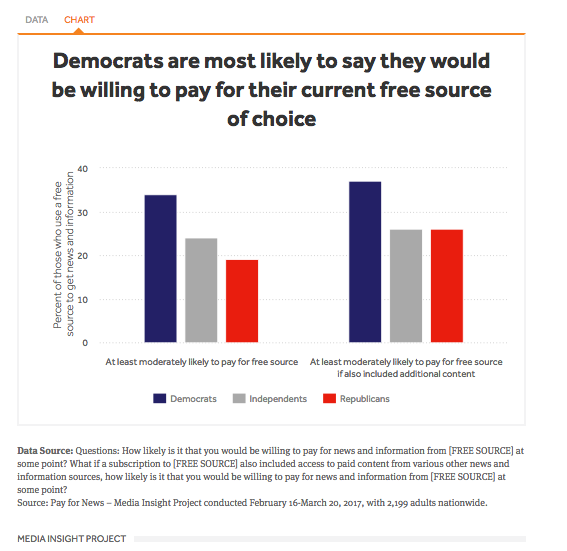The growing partisan divide on the performance of national media seems to have a curious exception: Democrats and Republicans are very similar in how they consume news.
That’s the headline finding of a new report today from the American Press Institute and AP-NORC center at the University of Chicago. It comes on the heels of a Pew Research survey earlier this week finding Republicans, by a huge margin, think the national news media has a negative effect on the country. Democrats much less so.
Even so, the new report finds, roughly equal percentages of Republicans and Democrats:
– Get news multiple times a day (71 percent R/72 percent D).
– Actively seek out news (65/68).
– Get some or all their news from social media (75/75).
– And pay for news (56/58).
The Republicans, however, are less trusting of what they watch and read, and less satisfied with what they get when they do pay. And, no big surprise, they are much more likely to get news from Fox News (40 percent vs. 8 percent of Democrats).

The report, based on two surveys of a total of more than 4,000 adults in February and March, also found few Republicans (20 percent) said that news media “keeps them well-informed on important issues,” and even fewer (8 percent) thought news from media “is very accurate.”
Another question elicited the sharp partisan difference Pew found. Among Republicans, 59 percent agreed that “news organizations prevent political leaders from doing their job,” compared to 17 percent of Democrats.
A flipped version of the question got a similarly split response. Of the Democrats, 81 percent said that critical coverage “keeps political leaders from doing things that shouldn’t be done.” Only 37 percent of Republicans agreed.
Tom Rosenstiel, API’s executive director, told me that asking several versions of trust and watchdog questions was useful as a touch point to older surveys done by various organizations.
“Support for the watchdog function holds up well,” he said, especially with so many Democrats suspecting wrongdoing in the Trump campaign and administration.
I also asked Rosenstiel about a separate finding that caught my eye. While more than 60 percent of respondents said that they are following national politics and government closely, fewer than 15 percent said the same about local politics and government.
To my mind that does not bode well for metro and smaller regional papers as they are now redoubling efforts to sell more digital subscriptions as print and digital ad revenues slump.
“I think three things are going on,” Rosenstiel said. “Clearly this (the survey) was done at a time when national news is especially hot.”
“Years ago, local used to rate much higher. But over time people have been able to access to a lot of national news so much more easily – and often for free.
“The third thing is that local news organizations have shrunk. So there is less there. It’s a trifecta.”
API’s biggest applied research push in recent years (with chains like Gannett and McClatchy developing similar programs) has been to help local newsrooms identify topics of particular interest to their community. Investigative stories consistently score high.
To get more paying readers, Rosenstiel said, local news organizations need more discipline about what makes for compelling content and need to develop more of it.







